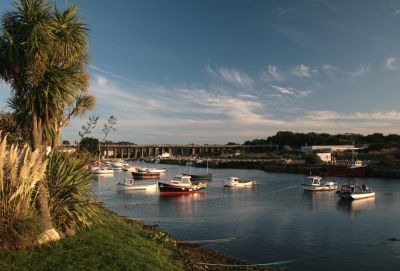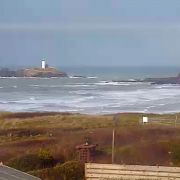
Situated on the opposite side of St Ives Bay, Hayle is famed for its three miles of golden sand. The beaches start at the mouth of the estuary, which is regarded as an international quality bird-watching spot. Sightings include avocets, ospreys and a host of wading birds. The roadside verges in this area are good places in which to find wild orchids.
Following the crescent of the beach brings you to the first lifeguard patrolled beach - Hayle Towans. Slightly more sheltered from the Atlantic waves and nearly 2 miles long it offers plenty of room for the whole family.
Next is Gwithian, popular with both locals and holiday makers. This is one of the most popular surfing beaches in the area and holds a decent sized swell. Beneath the sands lie the remains of one of Cornwall’s oldest churches. The village of Gwithian is an attractive cluster of cottages and church on the winding coastal road between Hayle and Portreath.
The stretch of Hayle sands end at Godrevy Point where Godrevey lighthouse stands on an island about 50 metres out to sea. The point and car park are owned by the National Trust.
Hayle town is divided into two districts, Copperhouse and Foundry. Both these names reflect Hayle's industrial heritage which dates back to the time when the Phoenicians traded for tin over 2000 years ago. Even earlier, during the Iron Age, Hayle was on the major route to St Michael’s Mount.
Phillack Church was originally the parish church for the town of Hayle and was first built in the 15th century. Much of the present building dates from the 19th century. The small stone, projecting over the gable of the south porch is from much earlier. It is inscribed with the Xi-Rho symbol of early Christianity and is believed to date from the 6th century. Next door is an old pub with the wonderful name of The Bucket of Blood. Among the dunes in this area are the remains of an explosives factory which employed many locals during the First World War.
Paradise Park is a theme park with attractions for the whole family. It has an extensive collection of birds but is also a breeding centre for rare species and a conservation site for the Cornish chough. There is a small zoo and a children’s adventure playground. This part of Hayle was where many of the larger houses were built at the time when the tin industry was thriving.
A few miles outside Hayle, the attractive village of St Erth was once on the main coaching route from London to Penzance. The Star Inn is the original 16th century coaching inn and stands in the centre of the village. The area around the old bridge and church is particularly attractive and there are pleasant walks along the river.






















